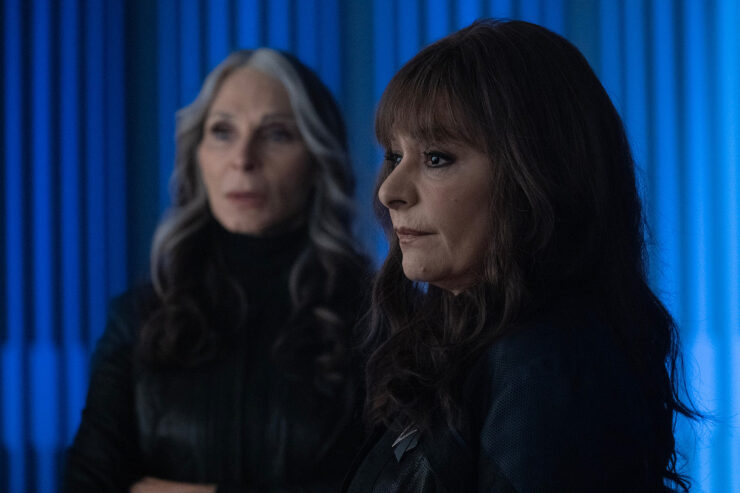Whatever one might say about this season of Star Trek: Picard, it absolutely has people talking. This season has achieved quite the Q-rating (far more than the season with Q in it). This is purely anecdotal, but I’ve been seeing a lot more people talking about this season than they have the other seasons, or even the other current Trek shows—more to the point, I’m seeing people who almost never talk about Star Trek talk about this season of Picard.
After this episode, they’re going to be talking even more…
Honestly, part of me wonders what even is the point of reviewing episodes of Picard season three, because this is pretty much entirely fan service occasionally broken up by plot. Mind you, it’s really really good fan service, which is good, because it is not a really really good plot. And I watch each episode and enjoy the hell out of it, and I’ve been eagerly looking forward to the next bit every week.
But hey, I’ve come this far…
Three important things happen in this episode, and it’s probably what all the conversations will be about for the next week.
The first is that we fucking finally find out what’s behind the red door in Jack Crusher’s brain meats: it’s the Borg. Yes, somehow Jack inherited Borginess from his old man. When Troi discovers this during their telepathic hypnotherapy session, she immediately breaks their connection and runs to Picard, not just to tell him about what’s happening with his son, but also to initiate protocols that are in place for how to deal with someone compromised by the Borg. Marina Sirtis does these scenes very well, and I have to say that the writers of Picard have done a better job with her as a therapist in this episode, in “Nepenthe,” and in “Surrender” than the writers of TNG did for the seven years that show was on the air.
Devastated by this news, Jack—aided by his telepathy—steals a shuttlecraft. I want to complain about how ridiculously easy it is for Jack to do so, but that ship sailed (so to speak) in Trek years ago. I mean, a de-powered Q stole a shuttle, er, somehow in TNG’s “Déjà Q,” and at that point it became obvious that a bored paramecium could steal a Starfleet shuttle without a problem, so, y’know, whatever.
Jack listens to the voices that are still in his head, and finds himself a Borg Cube. Just as his old man was Locutus, Jack will be Vox—the voice of the Borg. (Why they need a voice is unclear.)
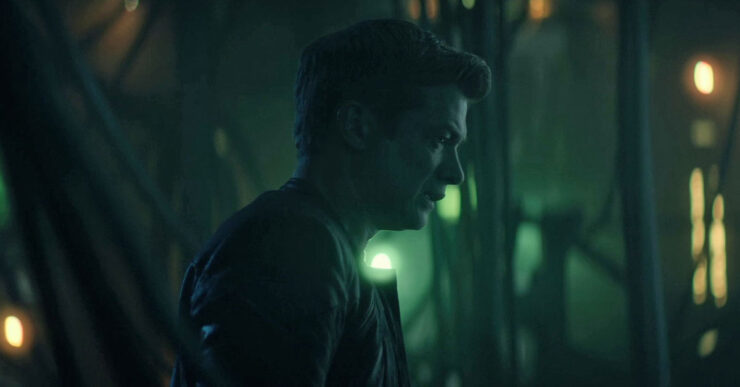
The explanation for this almost makes sense. We’ve already seen that these versions of the changelings are evolved, and the Borg have also evolved in a way: altering their drones’ biology instead of simply changing them by grafting technology onto them. Picard’s Irumodic Syndrome happened, not because of his genetics, but because of how the Borg altered him when they assimilated him in TNG’s “The Best of Both Worlds.” Specifically he was altered to be the Borg’s mouthpiece.
Those alterations conveniently explain a retroactive plot hole. In First Contact, Picard was able to hear the voices of the Borg (in much the same way Jack has been hearing voices), and yet we met several other ex-Borg on Voyager—the primary example being Seven of Nine, of course, as well as Icheb and the other kids rescued in “Collective,” not to mention the ones encountered in “Unity”—who did not hear the voices of the Collective the way Picard did in the 1996 movie. Yet Picard was only assimilated for two-and-a-half seconds, while Seven (to give one example) was part of the Collective for twenty years.
This alteration to his parietal lobe is what the changelings were after, and the fact that he passed it on to Jack is why they’re after him, too. Apparently, the rogue changelings were working with the Borg, infiltrating Starfleet in order to make alterations to Starfleet transporters so that Picard’s altered DNA would be made part of the transporter architecture.
The end result of this is that anyone whose brains aren’t fully formed yet—in humans, it’s anyone under the age of twenty-five—becomes assimilated by the Borg. These newly created drones proceed to attack the older officers, while the newly networked fleet is now entirely under Borg control.
Conveniently, this means that most of our main characters—not just the Big Seven, but also Shaw, Musiker, and Seven—are spared. For a little extra angst, La Forge’s two daughters are not spared. Neither are Mura or Esmar, and seeing a Borgified Esmar sitting in the command chair declaring Titan to be under Borg control is just heartbreaking.
Buy the Book
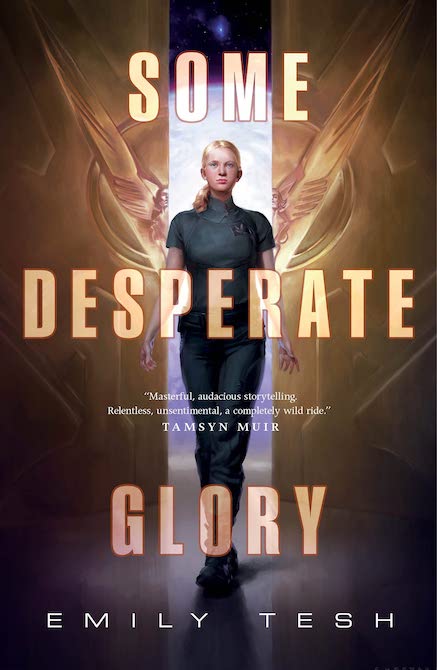

Some Desperate Glory
How much sense this makes is, um, questionable. First of all, the notion that the changelings would just be lackeys working for the Borg is ridiculous. Yes, this is just a batch of rogues—Worf made that clear when he explained back in “Seventeen Seconds” that Odo warned him about these changelings, who were not part of the Great Link any longer—but still, it’s a real come-down for them.
And the Borg targeting Starfleet, on the one hand, makes absolutely no sense for the Borg as they were created and established on TNG. Back in “Q Who” when we first met them, Q described them thusly: “They’re not interested in political conquest, wealth, or power as you know it. They’re simply interested in your ship. They’ve identified it as something they can consume.”
On the other hand, it’s in keeping with the rather boring direction Voyager took them in, turning the Borg Queen into a mustache-twirling villain who views Starfleet as a foe they need to torment and take out. Which makes nothing like sense for a massive collective of drones, to whom Starfleet should be, at best, a minor annoyance, and who anyhow shouldn’t be concerned with revenge or nonsense like that.
By the by, we see—or, rather, hear—the Borg Queen in this episode, and it’s one of two more past actors brought back for a guest shot, following Michelle Forbes in “Imposters” and Tim Russ in “Dominion”: Alice Krige. Unsurprisingly, we only get Krige’s voice. Krige had already proven willing to voice the Queen again (in Lower Decks’ “I, Excretus”), but for Picard season two, the live-action role was re-cast with Annie Wersching, likely because the now-nearly-seventy-year-old Krige didn’t want to go through the process of being made up like the Queen. Wersching, however, died tragically of breast cancer earlier this year, and instead we get Krige’s voice and a shadowed figure that’s supposed to represent the Queen.
The other is a delightful surprise, though like Forbes’ Ro, she appears to come to a tragic end: Elizabeth Dennehy as now-Admiral Shelby. (In a nice touch, she’s given the first name of Elizabeth, which is the actor’s first name, and also the name she was given in the New Frontier novels by Peter David in which she was a main character. She also worked her way up to admiral in those books, so this is even consistent with that!) Shelby is in charge of the new flagship of the fleet, which is introduced during Frontier Day: the U.S.S. Enterprise, NCC 1701-F.
And then she’s shot by the assimilated members of her crew. The transmission of her distress call is cut off before we see the end result of her being shot, but she is shot, and the drones are unlikely to be using the stun setting.
Shelby was introduced as a Borg expert in TNG’s “The Best of Both Worlds,” and has consistently been a favorite among the show’s guest stars, so it’s nice to see her back, though her ending kinda sucks. Riker even comments on the irony of her, of all people, introducing a networked fleet, a very Borg-like technological advancement.
Realizing they need to get the hell off the ship, our heroes gather on the maintenance deck to try to snag a maintenance shuttle because shuttlecraft aren’t part of the fleet-wide ship network. It’s not clear why the shuttles aren’t, except, I guess, that the plot won’t work otherwise.
The crew has been in a running firefight with the assimilated Titan crew (with the good guys all firing on stun), and the action is set up in such a way that it contrives for Shaw, Seven, and Musiker to stay on board while the TNG Reunion Gang all board the shuttle.
Shaw is then killed, which is the second of the important things that I think people will be talking about. His last words are to finally call his first officer “Seven of Nine,” which he does while saying that the ship is now hers. Given that the ship is under Borg control and most of her crew is either assimilated or dead, that’s kind of a dick move on his part, but that’s in keeping with the character.
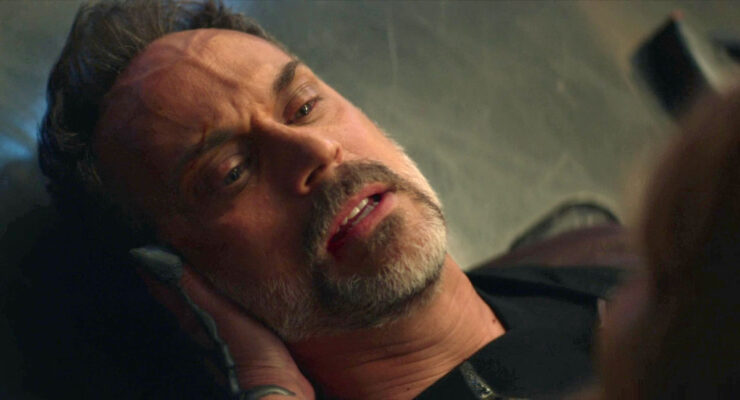
While I absolutely adore Todd Stashwick’s work in playing Captain Liam Shaw, I really intensely dislike the character. Yes, he got a lot of the best lines, but he’s also an asshole, and he shouldn’t have waited until he was on his metaphorical deathbed to stop dead-naming Seven.
It’s to Stashwick’s credit that a large chunk of the fanbase were all “who’s this asshole?” in “The Next Generation” and will likely be all “you killed Shaw, you bastards!” this week. But still, I’m kinda glad the door is more or less closed on there being a Shaw-focused Titan series on Paramount+. (And the door is open for a Seven-of-Nine-focused Titan series, which I’d be all for…)
Then, finally, we have the big moment at the end—the third important thing people will be talking about, and possibly the thing people will be talking the most about. Back in “The Bounty,” La Forge père et fille discussed something in Hangar 12, and we find out what that is: La Forge has, in his spare time during his tenure as head of the Fleet Museum, been reconstructing the Enterprise-D. It’s not connected to the fleet network.
(Apparently, the Enterprise-E is unavailable. When La Forge mentions that, Worf defensively says, “That was not my fault.” Given that Worf is now wearing a Starfleet uniform with captain’s pips, it’s likely that Worf was given command of the E after Picard’s promotion to admiral, and now we know something pretty dang serious happened to it….)
Of course, my first thought is, “Why the hell are you going on the D, when the Defiant is right there?” As it is, it’s not even remotely clear what one forty-year-old ship is supposed to do against an entire Borg fleet. Achieve victory through the power of nostalgia?
All right, let’s be fair. That was not my first thought; it was my fourth or fifth. My first thought was, “Damn, they re-created the bridge perfectly,” and my second thought was, “Damn, it’s good to see them all on that bridge again,” and my subsequent thoughts were all other forms of fangoobery glee before my critical brain finally jumped in and pointed out the logic flaws.
I do like the fact that, while they’re talking on the bridge about how they’re family, Troi makes sure to remind them that Jack, Sidney, and Alandra are also their family, and they need to be rescued. This almost makes up for the fact that La Forge seems utterly unconcerned about his daughters once they arrive at the Fleet Museum. It’s frustrating, as LeVar Burton has generally done his best work as Geordi La Forge in this season, but his lack of concern for his daughters once they left Titan stands out, and not in a good way.
Oh, we get one more bit of fan service on the bridge of the Enterprise: the computer voice, which is Majel Barrett’s. It’s obviously pulled from earlier recordings of the late actor’s work doing the voices of Starfleet computers (which is why the title character is referred to as “Captain Jean-Luc Picard”), but it’s still nice to hear Barrett’s voice one more time in a season that has been all about seeing folks one more time.
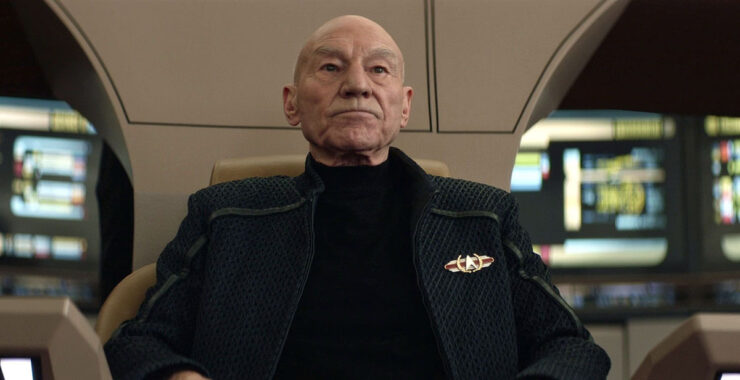
One final bit of fan service: we get a screen showing the fleet gathered for Frontier Day (which is explicitly established as the anniversary of the launch of the NX-01 in Enterprise‘s “Broken Bow“). Among the ships are the U.S.S. Okuda (named after Mike & Denise Okuda, co-authors of the Star Trek Encyclopedia, and Mike also did scenic design work on the first wave of spinoffs and several of the movies, including creating displays very much like the one showing all these ships), the U.S.S. Drexler (named after graphic and technical artist extraordinaire Doug Drexler), the U.S.S. Sutherland (the name of Horatio Hornblower’s ship in C.S. Forrester’s novels, one of Gene Roddenberry’s primary inspirations for Star Trek), the U.S.S. Tourangeau (after Sean Tourangeau, who designed the previous iteration of the U.S.S. Titan, as seen on the Titan novels and on Lower Decks), the U.S.S. John Kelly (named after the astronaut played by Phil Morris in Voyager‘s “One Small Step“), the U.S.S. Ibn al-Haythem (named after Hasan Ibn al-Haythem, the medieval astronomer), the U.S.S. Zheng He (named after Zheng He, the Ming Dynasty mariner, and also the ship Riker was in command of in “Et in Arcadia Ego, Part 2“), the U.S.S. Hikaru Sulu (named after George Takei’s character on the original series), the U.S.S. Forrest (named after Vaughn Armstrong’s character on Enterprise, who was himself named after DeForrest Kelly, who played Doctor McCoy on the original series), the U.S.S. Huygens (named after Christiaan Huygens, the seventeenth-century astronomer), and so many others that lots of fans will have fun pausing their playbacks and picking out…..
Somehow, this is all supposed to be tied up next week. Not really clear as to how, though I’m willing to bet real money that the running time will be a bit longer than the usual 45-50 minutes…
Keith R.A. DeCandido wrote the TNG novel A Time for War, a Time for Peace in 2004, in part to be the coda for the TNG crew that Star Trek: Nemesis utterly failed to be. The book was a USA Today best-seller and stayed in print for the better part of two decades, so he can’t complain too much that his notion has been bigfooted by Terry Matalas and the gang…










